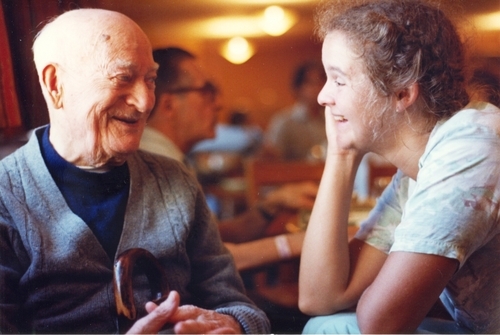Semmens, Edmund J.: my naval experiences (March 3, 2005)
Interviewee: Semmens, Edmund J.
An interview/narrative of Edmund J. Semmens's experiences during World War II. Commander Semmens served with the Calgary Highlanders. Interview took place on March 3, 2005.
Interviewer: White, Cameron
ABSTRACT: Commander Edmund J. Semmens Born in Calgary Alberta in 1920, Cdr. Semmens first military experience was as an NCM in a local army reserve unit, the Calgary Highlanders, which he joined in 1937 primarily because of a lack of employment opportunities at the height of the Great Depression. Upon the outbreak of war the Calgary Highlanders, for reasons unclear to Semmens, were disbanded. Applied for both the RCN and the RCAF, the navy contacted him first in early 1941. Undertook his basic training at the Naval Division in Calgary, known as HMCS Tecumseh. This training was very basic and was mostly indoctrination into the basic naval traditions. Seamanship training was limited to rowing a small boat on Lake Chestermere and did little to prepare him for the rigors of service in the North Atlantic. Discusses his trainers, who included a tough RCNR Gunners mate, an older RN torpedo Bosun, and an RCNVR Lt. instructor whom he holds in high regard. Facilities consisted simply of a drill floor and stanchions upon which sailors practiced slinging their hammocks. Few training aids were available; much was left to the imagination. At HMCS Tecumseh word was circulated that anyone with grade 12 could apply to take a special electronics course at U of T, Semmens applied and was accepted. Some felt that they had been told that enrolment in the course would guarantee a commission, but Semmens was not among them. While housed at HMCS York, the Toronto Naval Division, he undertook a four month electronics and sound theory course at U of T, all theoretical. This was followed by four months of practical ASW training in Halifax which included work with an advanced ASDIC simulator which he describes in some detail. Semmens felt that this ASW training was very thorough. Semmens was then deployed to his first ship, HMCS Kamloops, operating in the Gulf of St. Lawrence, as a submarine detector, rank: Able Seaman. Operational training was limited to further use of the "attack tables", the asdic simulator, when in port, does not recall ever training with friendly submarines. Discusses the quality of the officers on his first two ships, most of his CO's were experienced sailors, RCNR. Makes particular note of Grant Garden, a popular and capable RCNVR man who recommended him for a commission aboard his second ship, HMCS Stratford a Bangor-class minesweeper. Notes the high level of turnover among officers, had five Captains in two years. Makes note of a Lt. Keeler whose abrasive attitude triggered a minor mutiny, for which none were punished. Turnover was less evident among the ratings, except for the position of Head Submarine Detector. Discusses the equipment aboard HMCS Stratford, his first lengthy posting; type 128 ASDIC, radio telephone, no radar until late 1942 (SW1C), lucky to have a gyrocompass as she was a minesweeper. Promoted to Acting Sub-Lt., January 1, 1944, sent to Regina for three months of informal officer training, and then to King's College in Halifax for further training. Assigned to HMCS Miramichee, minesweeper based at Esquimalt, in September 1944, patrolled Dixon Entrance for submarines, also advised to be on the lookout for Japanese fire balloons, an uneventful assignment save for the weather, which was at times worse than the North Atlantic. Further discussion of equipment, no HD/DF, no hedgehog. Equipped for minesweeping, but not trained. Unaware of the RN/RCN equipment disparity, thought they had the best. Discusses difficulties in operating ASDIC Speaks highly of the "dry" Bangor-class ships. Recounts two interesting assignments, removal of a minefield of St. John's, transport of medical staff from Sidney to St. John's to treat sailors injured in a fire at a Knights of Columbus Hall. Never witnessed a U-boat attack. Postwar commanded two ships, became Esquimalt training coordinator.
Rank: Commander.
- In Collection:
- 1 sound recording (MP3)
- 35.68536, 139.75309
- One original audio cassette in Special Collections.
- Canadian Military Oral History Collection
- SEJ_452
- Special Collections Finding Aid: https://search.archives.uvic.ca/military-oral-history-collection
- December 5, 2012
- Digital sound recording in .wav format at 16 bits and 44 kHz. In .mp3 format at 56 kbps and 24 kHz. Digitized by JF, technical and cataloguing metadata provided by JF and JP. Interview migrated to digital format for UVic Special Collections in 2012. Migration metadata by KD and MT.
- Rights
- This interview has been posted with the understanding that it may be used for research purposes only. Should the interviewee or their heirs have any objections to this interview being accessible on the Internet, it will be removed promptly. Contact UVic Special Collections for permission if using for other than research purposes: speccoll@uvic.ca
- DOI
| Thumbnail | Title | Date Uploaded | Actions |
|---|---|---|---|
|
|
SC141_MilitaryOralHistory_GenericThumbnail |
|
|

|
Semmens_E_0452_01.mp3 |
|